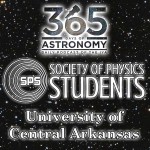Podcaster: Dr Brett Carter
 Title: Space Weather and its Impact on Our Technology-dependent
Title: Space Weather and its Impact on Our Technology-dependent
Organization: The Society of Physics Students (SPS) at The University of Central Arkansas
Link : The Society of Physics Students (SPS) at The University of Central Arkansas
Description: Space weather is commonly associated with solar eruptions that cause large geomagnetic disturbances and bright auroral displays after they impact the Earth. It has been the topic of significant research interest and importance in the last century, primarily because of its effects on various modern technological applications; including, and certainly not limited to, electricity grid operations and satellite communications.
In recent decades, our scientific interest in space weather has accelerated, along with our development of advanced technologies, and our reliance on them. The most serious threat posed by space weather is its proven ability to cause long-term and costly interruptions in electrical power supply, upon which many other aspects of modern-day life are very heavily reliant; e.g. the provision of water and gas. As such, this threat has been a primary motivation for scientists to investigate and better understand the near-Earth space environment, and how we as a society can better protect ourselves against future severe space weather events. Up until recently, the infamous 1859 Carrington event – the most severe geomagnetic storm in modern history – has been considered the ‘worst-case scenario’. Unfortunately, our ability to fully understand the Carrington event is hampered by the lack of scientific observations at the time. In July 2012, a Carrington-scale solar eruption directly hit the STEREO-A spacecraft, which is located ahead of Earth in Earth’s orbit around the Sun. The eruption originated from a region on the solar surface that was directly facing Earth only 1 week prior. It is abundantly clear that this event would have had significant consequences had it hit Earth, but exactly how lucky were we that it missed? To answer this question, the economic and societal impacts of such an event will be discussed. A direct comparison with other natural disasters – for example, hurricanes, earthquakes and floods – shows that a severe space weather event like that in July 2012 is capable of being the single most expensive natural disaster in human history.
Bio: The Society of Physics Students (SPS) at The University of Central Arkansas is incorporates outreach, demonstrations, tutoring and guest speakers into our SPS Chapter.
Dr Brett Carter, is a researcher at RMIT SPACE Research Centre.
Today’s sponsor: This episode of “365 Days of Astronomy” is sponsored by — no one. We still need sponsors for many days in 2016, so please consider sponsoring a day or two. Just click on the “Donate” button on the lower left side of this webpage, or contact us at signup@365daysofastronomy.org
End of podcast:
365 Days of Astronomy
=====================
The 365 Days of Astronomy Podcast is produced by Astrosphere New Media. Audio post-production by Richard Drumm. Bandwidth donated by libsyn.com and wizzard media. You may reproduce and distribute this audio for non-commercial purposes. Please consider supporting the podcast with a few dollars (or Euros!). Visit us on the web at 365DaysOfAstronomy.org or email us at info@365DaysOfAstronomy.org. This year we will celebrate more discoveries and stories from the universe. Join us and share your story. Until tomorrow! Goodbye!

